A few months ago, I submitted an article I’d spent hours working on. It felt good.
Too good, apparently, because the client ran it through an AI detector and sent me a screenshot that screamed, “99% AI-written.”
I stared at it for a good minute, thinking, Excuse me? I wrote that with my own two hands.
It hit me then how messy this whole “AI vs. human writing” thing has become.
Everyone’s trying to sound natural, pass the detectors, and keep their content from being flagged. And honestly? It’s exhausting!
So when I came across Natural Write AI, which claims it can make any text sound human enough to pass even the strictest AI detectors, I had to see if it could actually back that up.
And this is my Natural Write AI review.
Viktiga slutsatser
- Natural Write AI can make AI drafts sound more human, but it mostly polishes. You still need to bring in your own ideas and structure.
- It works best on drafts that are already clear and well-written. Messy or unclear text will not improve on its own.
- Passing AI detectors is not guaranteed. Natural Write can reduce AI-like signals, but it does not always avoid detection.
- Undetectable AI tools are more reliable for turning AI text into fully human-sounding content and avoiding detection.
What Is Natural Write AI?
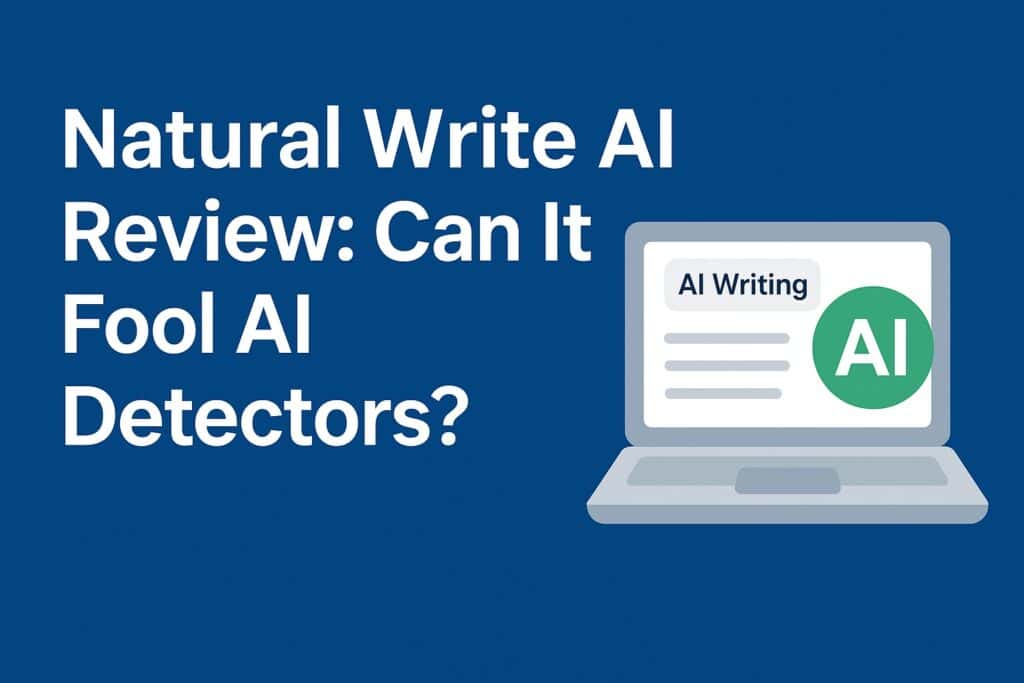
Natural Write AI is one of those tools you stumble on after getting tired of being told your writing sounds like a robot.
It calls itself a “humanizer,” which basically means it takes text that feels too mechanical and softens it to sound more natural.
On their website, they say it’s trained on over a million samples of essays, academic papers, and AI text.
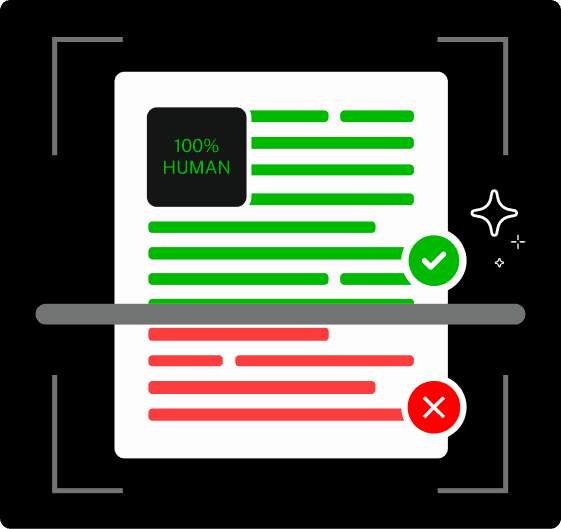

Oroa dig aldrig för att AI upptäcker dina texter igen. Undetectable AI Kan hjälpa dig:
- Få din AI-assisterade skrivning att synas människoliknande.
- Bypass alla större AI-detekteringsverktyg med bara ett klick.
- Användning AI säkert och självsäkert i skolan och på jobbet.
The idea is that it knows what makes writing feel human and what triggers detectors to think it’s machine-made.
You paste your text in, it analyzes it, and then rewrites it in a more natural rhythm.
The team behind Natural Write AI claims that it can help students, marketers, and content writers avoid the awkward moment when an AI detector calls out their work as “too perfect.”
It’s also built to work across popular detection tools like GPTZero, Turnitin, and others.
Key Features of Natural Write AI
- AI-Score or Detection Check: The Natural Write AI Detector gives your content a quick “AI-likelihood” reading. This tells you if your writing looks too polished or robot-ish before you send it out.
- Humanize/Rewrite Engine: Once you have your score, you can hit a “Humanize” button. The system then tweaks syntax, vocabulary, and sentence flow. It’s just an attempt to make the text sound like you, not a machine.
- Detector-Bypass Focus: The site is built with the specific goal of reducing phrases or patterns that trigger AI detectors (like GPTZero, Originality AI, Turnitin AI) in mind. The makers say the rewriting engine is trained on over 1.2 million sample texts to do this.
- Broad Support: The tool supports multiple languages and claims to work for more than just English. So if your text has bits in another language or you write for bilingual audiences, that’s a plus.
- Fast Workflow: The most appealing part about this website is that it eliminates the need for multi-tool juggling. You get the AI-detection scores, humanizing feature, and revised output in the same window.
How Well Does Natural Write AI Actually Work?
After seeing too many marketing claims about “undetectable” writing, I decided to stop trusting words and start testing results.
I built a simple experiment using the same logic as ZDNets well-known benchmark for AI content detectors.
What I Did
I wrote three pieces of text:
- One completely written by me (human).
- One generated by an AI writing tool.
- One generated by AI and then refined using Natural Write AI’s Förmänskliga funktion.
I ran all three through:
- Natural Write AI’s own detector and humanizer, and
- Oupptäckbar AI-detektor och humaniserare.
That gave me six total results to compare. How each tool rated “human vs. AI” for each type of text.
- Human-written text result in Natural Write AI
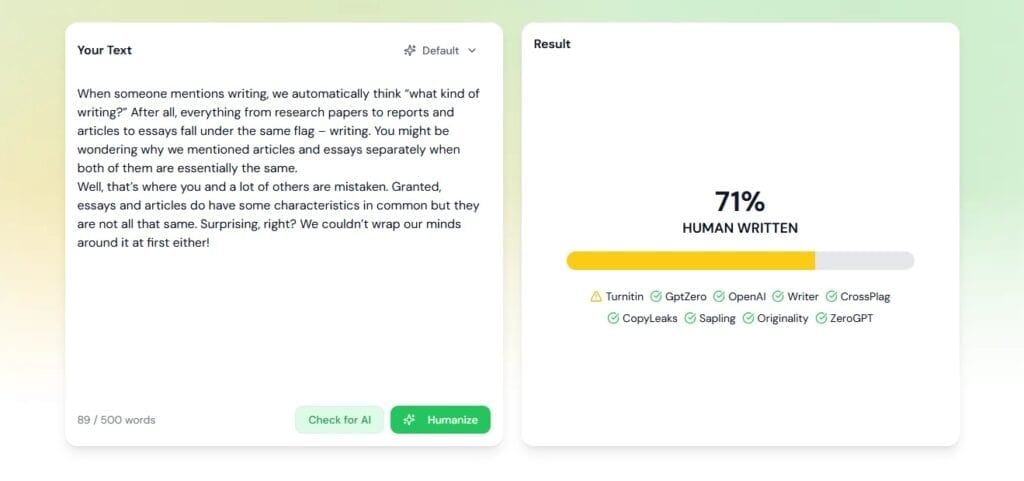
- AI-generated text result in Natural Write AI
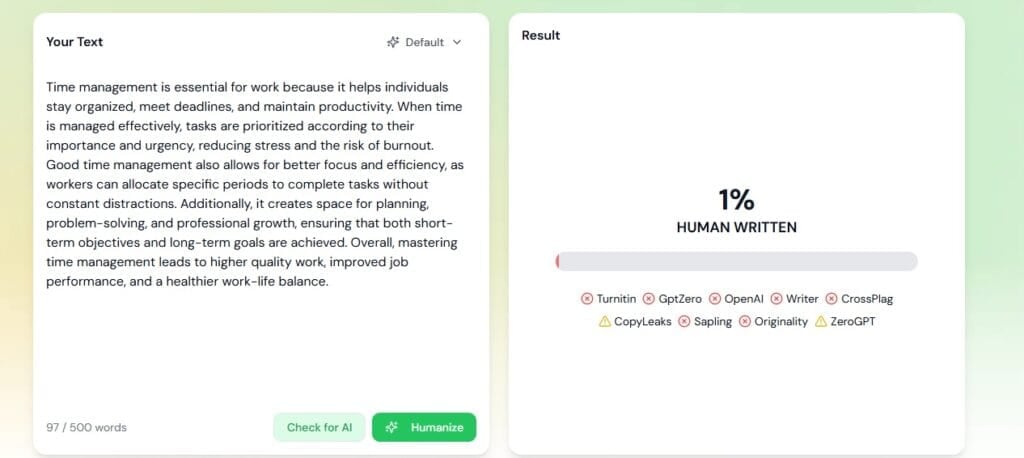
- AI + Humanized text result in Natural Write AI
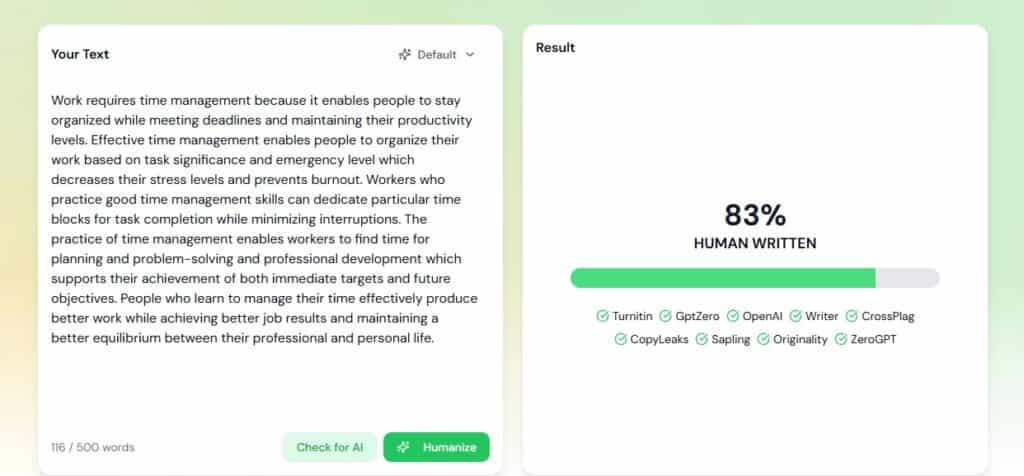
- Human-written text result in Undetectable AI
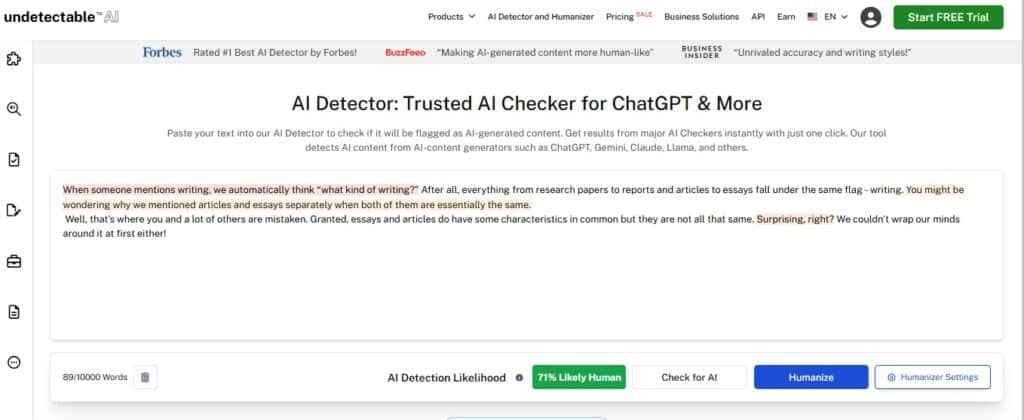
- AI-generated text result in Undetectable AI

- AI + Humanized result in Undetectable AI

What I Found
The human-written text performed as expected across both tools, i.e., scored strongly in the “likely human” range.
The AI-generated text got flagged clearly on both detectors.
When I ran the AI through Natural Write AI’s humanizer, the results noticeably improved.
Detectors showed lower AI-likelihood percentages, and a couple even shifted into the “human-like” range.
However, when I ran the same test of AI + humanized output through Undetectable AI, the difference was a bit… shocking. It didn’t reduce the AI-likelihood by a lot, which was surprising but also good to know.
So, yes, I’d say Undetectable AI is more reliable since it won’t magically reduce the AI percentage just to please you.
It’s stricter, which is just what you need to make sure your content doesn’t get flagged by a teacher or a client.
Natural Write AI Weaknesses and Limitations
I started using Natural Write because I liked the promise: “take your AI‑draft and make it sound human”.
Over time, I discovered it’s useful, but it also carries specific limitations. Knowing them has helped me use it more wisely.
Output Quality Relies on Input
Natural Write humanize AI works best if you feed it a draft that already has decent structure, clear meaning, and great content.
But if the text is confusing, poorly organized, or full of factual slips, there’s only so much it can do. It’s great at fixing tone and rhythm, not at rebuilding broken ideas.
Risk of Losing Your Own Voice
Because Natural Write aims to “humanize” text and make it sound natural, sometimes it smooths out the quirks or personal touches that give my writing its character.
For example, I might use a certain rhythm or a particular phrase that reflects me. After rewriting, the text sometimes sounds more generic.
So I now always check, “Did I still sound like mig?"
If the tool’s version feels too ‘neutral human’, I go in and re‑inject my voice, anecdotes, or idiosyncrasies, but again, that takes time and effort.
False Confidence Around Detector‑Bypass
One of the big draws of Humanize AI Natural Write is its advertised ability to get past AI‑detectors (like GPTZero, Turnitin, etc). I found that this promise can give a false sense of security.
While the tool may reduce certain “machine‑like” signals, it doesn’t guarantee detection will never happen or that your content adheres to the ethics of your context.
You should treat the “pass detector” part as en factor, not the only factor. I still manually review for originality, tone, and accuracy.
Limited Improvement of Substantive Content
Natural Write does a fine job of rewriting sentences for tone, flow, and human feel. But it doesn’t enhance your underlying argument, research depth, references, or creativity.
Long, substantive pieces (for example, a theological chapter or detailed memoir section) still need full drafting, rewriting, and careful thought.
Natural Write helps with polish, but not with the heavy lifting of writing from scratch, doing deep reflection, or building logic.
Cost, Word‑Limits, and Workflow Fit
Using Natural Write frequently (especially for long documents) involves either frequent subscriptions or managing around word limits and modes.
If you’re working on a book‑length manuscript or one with many chapters, paying attention to cost, versioning, draft management, and ensuring you integrate this tool into your usual writing process becomes important.
If you ignore these logistics, you can end up with fragmented versions or workflow bottlenecks.
Ethical / Academic‑Use Considerations
If you’re in an academic, theological, or highly professional context (like your memoir or book projects), you need to ensure the output remains your ideas, your voice, and your research.
Letting the tool do too much can muddy the boundary between “my writing” and “edited by the tool”.
So I make a point of using it efter I’ve done the genuine work because then it’s mine, and the tool helps me polish.
Detection Accuracy
The detection‑accuracy question is one I’ve come back to again and again. On paper, Natural Write AI detector claims very high scores.
Their website states the humanizer model “exceeds 95%” undetectability across popular detectors like Turnitin AI, Originality.ai, and GPTZero in multiple testing scenarios.
But, and here’s where my experience comes in, they also make clear that “real‑world” conditions change things. According to their blog, detection accuracy for AI‑detectors in general drops once human edits, paraphrasing, or hybrid content is involved.
So, no, I don’t trust their 95% guarantee claim. It didn’t always turn out to be accurate, as per my experience.
Natural Write AI vs. Other AI Writing Tools
When I use Natural Write AI, what I value most is how it works as a humanizer.
I start with an AI‑generated draft, then feed it into Natural Write AI humanizer to smooth out phrasing, improve readability, and retain the original meaning.
In my experience, this tool preserves my voice better than some others. I still need to check for consistency and tone, especially in complex writing, but for taking a “draft to near‑final” step, it feels reliable.
And that holds true for almost all AI tools except for this AI Paraphraser from Undetectable AI. I treat it as a more automatic rewriting “quick fix”.
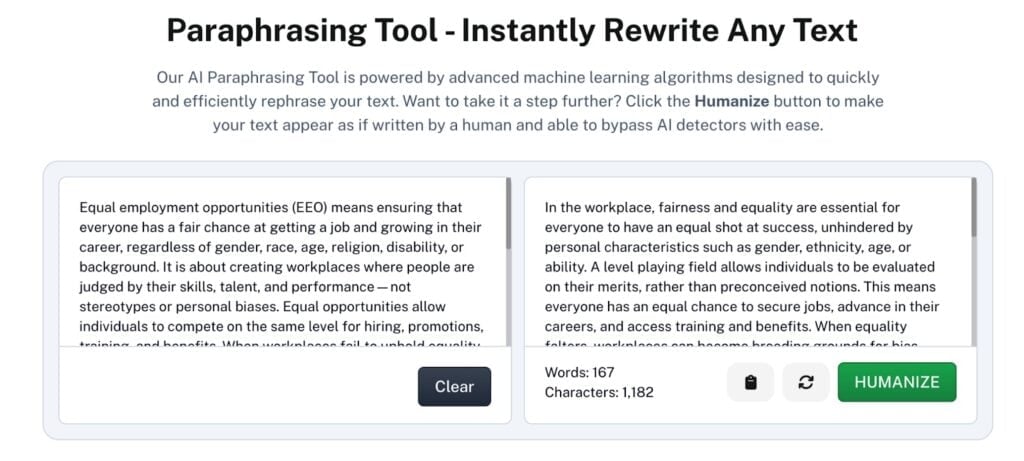
It is incredibly reliable when I need to take an AI draft and transform it into fully human-feeling text.
I like how it carefully restructures the content to preserve its meaning and natural flow instead of simply rewording sentences.
AI Stealth Writer by Undetectable A is another one of my favorite tools. If I could name just one tool that I blindly trust for bypassing AI detection, it’s this one.
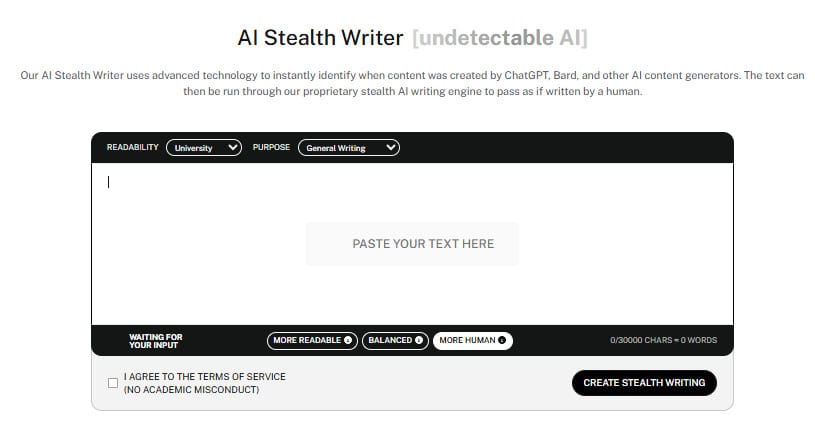
I have used Stealth Writer for my high-stakes projects, and it has never disappointed me. I always get results that read naturally and maintain the intended meaning.
Börja använda vår AI Detector och Humanizer i widgeten nedan!
Is Natural Write AI Worth It?
I certainly think Natural Write AI is worth a shot for quick edits or refining small pieces of content. I found it to be super time-saving in those aspects during my Natural Write AI review.
That said, when my priority is producing AI-assisted content that is not only human-feeling but also reliably undetectable by AI detectors, Undetectable AI’s tools are my top choice.
Yes, Natural Write AI has its place and is certainly useful. But I personally recommend Undetectable AI tools more for anyone who wants a dependable, all-in-one solution for humanizing and protecting AI-generated content.
For the most reliable way to humanize, refine, and protect your AI-assisted writing, try Odetekterbar AI.
